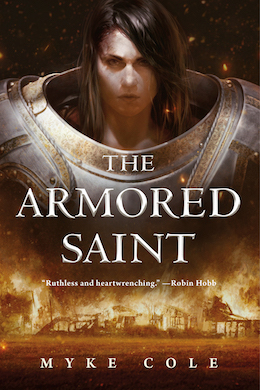Some months ago I was asked to read and review The Armored Saint, the new book by Myke Cole: it’s set in a quasi-medieval world, and since I’m the resident Medieval Guy (Twitter handle alert!) around here… well, someone thought it’d be a good match.
The thing is, Myke and I have written multiple articles together about ancient warfare. I’m telling you this up front because it’s the truth and I’m not about to hide it.
Something else I wouldn’t hide? My honest opinion.
And Myke knows it. So I don’t think he was surprised when I wrote and told him that if I agreed to review his book and it disappointed me, I was going to damn well say so. If that was going to be a problem between us, I told him, I needed to know.
Myke’s response? “Do it. I believe in this book.”
Well, Myke, I’ve read it. Twice… because I had to relive it again.
And you know what? I believe in it, too.
I believe in this world. I believe in its terrors and its taints. I believe in its humanity and, however small it is, its hope.
I believe in Heloise.
Look, Aragorn is amazing, but we all know that we need more and more strong heroes and heroines and heroinx in our reading lists who don’t look or act or love like him. This has ever been true, and I’m enormously glad to see society continuing its long-overdue corrective turn in this regard.
[Note: Spoilers ahead for a pivotal chapter of The Armored Saint.]
The most incredibly welcome part of that turn is the increasing volume of a diversity of voices who, through their unique life experiences, can bring us an increasing diversity of plots and characters and settings. All of which, it goes without saying, are the reason that we share a love for genre fiction.
Another welcome part of that turn, though, has been seeing scales fall from ignorant eyes as so many of us are educated about what we might have been missing all along—and, subsequently, witnessing the burgeoning ranks of the privileged who have rolled up their sleeves in order to put such lessons into action.
The end result of all this is a broad collective of people who are putting their shoulders against the rock of how-things-have-been in order to shove the damn thing aside. That communal effort is a good thing. It’s how the work gets done.
What I’m saying, in my long-winded way, is that Heloise would have been a welcome character at any time, but I think she arrives to a particularly ready audience today.
In the most simple terms, her journey in The Armored Saint moved me. This is one of those books in which each gut-punch is built in a simultaneity of poignancy and terror. At once a heroic tale and a brutal tragedy, the story it tells feels powerfully—at times, so very uncomfortably—real.
Cole’s prose has long been vivid. He excels at an unflinching immediacy of description. He consistently pursues the powerful simplicity of just enough. He nails that visceral quality in this book.
Especially when he’s talking about the viscera.
Which does bring up a complaint of sorts.
Here’s the cover copy for the book I got: “Myke Cole, author of the beloved Shadow Ops series, debuts a new epic fantasy trilogy with The Armored Saint, a tale of religious tyrants, arcane war-machines, and underground resistance that will enthrall epic fantasy readers of all ages.”
So much of that is true. His Shadow Ops series is indeed slick, and that’s a damn good book description… except… “fantasy readers of all ages”?
Well, no. In the fourth chapter of the novel Cole makes us witness the unspeakable horror of a Knitting. We watch, through the eyes of young Heloise, as a group of religious zealots eradicate a village that they believe has harbored a magic user. A young girl named Austre, bruised in ways that we cannot help but read, stumbles from the flames and the smoke and the screams. One of the zealots, Brother Tone, pursues her. She trips.
Heloise didn’t scream this time. She had no screaming left in her. The sickness was a low buzz in her belly. Her arms and legs felt weak and heavy. She closed her eyes, but it didn’t stop her ears, which heard the wet crunch as the Pilgrim brought the flail down again, and again, and again.
There is violence in here, grim and awful brutalization.
This is not a book for the wee ones, is what I’m saying.
For the rest of us, though? The Armored Saint is a really strong initial foray into what Cole is calling The Sacred Throne series.
(That said… seriously, Myke? A flail? You’re killing me, Smalls. Look, people, despite what Hollywood wants you to think—damnit, Peter Jackson, why’d you give one to Sauron?—the spiked-ball-and-chain flail is an essentially nonsense weapon that is deeply combat ineffective with almost zero practical usability and, yeah, I know this is supposed to be a review of the book and maybe this is really sorta a personal thing but this myth has me flailing here and auuuuugh…)
Buy the Book


The Armored Saint
The Armored Saint is not a long book, which can be its own kind of strength these days. In part this brevity is because, as if he’s one of the Tinkers in his story, Cole constructs his world by putting a new frame around old parts: the core setting, for instance, has put-upon peasants, an imperial presence, and many other general trappings of a standard quasi-medieval village. Cole wisely utilizes his readers’ familiarity with such conceits in order to step around the hundreds of pages of backstory we might get in a typical fantasy doorstop. After all, his focus here isn’t the political machinations of vast landscapes but the far more intimate and intricate business of telling us the story of a marvelous, impetuous young woman who comes of age and becomes a legend.
And there are many wonders in that story. The Armored Saint went places I did not expect, but it did so with a purpose and a principle. I don’t want to give anything away about the wrenching twists and turns of its plot—but I can tell you that I really enjoyed it. This is absolutely a “part one” of a larger legend, and I cannot wait to read its sequel.
Because I believe in Heloise.
I believe.
And you will, too.
 Michael Livingston is a Professor of Medieval Culture at The Citadel who has written extensively both on medieval history and on modern medievalism. His historical fantasy trilogy set in Ancient Rome, The Shards of Heaven, The Gates of Hell, and the newly released The Realms of God, is available from Tor Books.
Michael Livingston is a Professor of Medieval Culture at The Citadel who has written extensively both on medieval history and on modern medievalism. His historical fantasy trilogy set in Ancient Rome, The Shards of Heaven, The Gates of Hell, and the newly released The Realms of God, is available from Tor Books.










